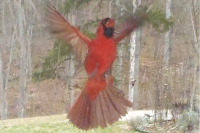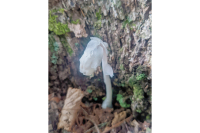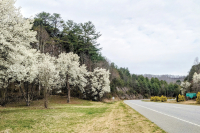Growing pains: Farmers pay the price as elk herd damage crops, fences
 It is a common story — a species once eliminated returns to find not everyone welcomes it back with open arms. The return of wolves to northern Wisconsin, the reintroduction of beavers to the United Kingdom, and now the elk in Western North Carolina.
It is a common story — a species once eliminated returns to find not everyone welcomes it back with open arms. The return of wolves to northern Wisconsin, the reintroduction of beavers to the United Kingdom, and now the elk in Western North Carolina.
After disappearing from North Carolina in the late 1700s, the elk have since made a comeback from the history books in the Great Smoky Mountains National Park — from zero to a successful and ever-growing herd in short time. But with their renewed success in their historic home, so comes a newfound set of problems.
The next chapter in the story of the elk recently began with the N.C. Wildlife Resources Commission giving the go-ahead for two Haywood County landowners to kill the massive herbivores. Citing property destruction and disruption of agricultural operations, a dairy farmer and the owner of a pumpkin patch applied to the state for depredation permits.
Those permits were granted by the head of the Wildlife Commission and give each farmer permission to kill one elk in an allotted time frame. They are the first of their kind awarded in the area around Cataloochee Valley — the section of the park where elk were reintroduced in 2001 and have proliferated.
Whether the permits are warranted, or will even be effective in the long run, is a question of debate. What is not debatable is that the species, as it expands outwards from the protection of Cataloochee Valley and into the cornfields and cow pastures of the farmers surrounding the park, is starting to step on toes.
Related Items
In the eye of the beholder
The reintroduction of elk to the Park started with two small herds of 52 elk in the early 2000s. After some difficulty establishing a breeding population, the herd jumped to more than 120 in 2009, the Park’s last official count. That was about the same year Tony McGaha’s phone really started ringing with local residents complaining about the elk.
“It’s getting more and more abundant all the time — all the calls,” said McGaha, who plays the role of agricultural agent, cattleman and cattle advocate in WNC, making him the ideal person to call when something goes wrong on the farm or in the back forty. “We used to never get them.”
Although a bulk of the herd stayed put in Cataloochee, where they pass the time posing for photographs for tourists and grazing in the flat valley floors, a contingent has since branched out into the surrounding communities of Jonathon Creek and Maggie Valley.
By McGaha’s estimates, there are about a dozen elk that are known saboteurs in the region. They’ve been blamed for desecrated graveyards, leveled plots of corn, trampled gardens, dead dogs — the list goes on. For McGaha and his neighbors, one of the most aggravating, and costly, attitudes of the elk is their blatant disregard for fences.
“The problem is they have no respect for a fence whatsoever,” McGaha said. “They try to jump them, and their back legs don’t get across, and they take it down.”
An elk-proof fence — more common out west where elk are a more common sight on the landscape — needs to be a little beefier than a typical cattle fence. Given that elk are a new neighbor for all WNC farmers, most have not invested in methods for keeping them out.
Hank Ross, the son of the dairy farmer who received one of the elk depredation permits, refused to talk about the family farming operation for the article. But he did point out that elk can be a costly nuisance and that the price tag for a brand new fencing is not negligible by any means.
Apart from trampling fences — which could mean cattle wandering onto roads and onto other people’s property — elk tend to spook cows. When an elk gets in the pasture, McGaha said, Bessie is known to take off running. If there is one thing a cow isn’t too graceful at, it is moving quickly.
While running, cows are exposed to all sorts of unnecessary risks, like broken and sprained limbs. McGaha says replacing a cow with broken leg can cost a farmer $2,000 to $3,000, and sometimes the best they can hope to get for the injured animal is to get “salvage value” for it — which means hamburger. There is also the risk of the elk transmitting disease to the livestock.
The owner of the pumpkin patch, who was also issued a depredation permit granting him permission to kill an elk until Oct. 1, could not be reached for comment. But state reports indicate the elk were squishing his pumpkins by stepping on them and bedding in the field.
“They just destroy it,” McGaha said.
While some environmentalists and elk enthusiasts are questioning the issuance of the two depredation permits, McGaha, who has had his own cattle fences destroyed by elk, said being a farmer and landowner in the area gives one a completely different perspective than that of the many sightseers who come to the area for the elk.
“It’s well, fine and good to look at them and see them when they’re not affecting your livelihood,” McGaha said.
He added that he is not convinced elk and farmers can coexist in Maggie Valley and Jonathan Creek. He’s not convinced there’s enough open space for the elk to roam. Meanwhile, he applauded the Wildlife Commission for addressing the concerns of local landowners by issuing the depredation permits but questioned whether they’ll have that great an impact.
“We’ll just have to wait and see,” he said. “They only issued two permits — that’s only two animals.”
For wildlife advocates, however, two permits might be two too many and their issuance sets a “dangerous precedent,” said Bill Lea, a wildlife photographer and conservationist from Franklin. The move also signals to landowners in the region that the Commission supports the killing of elk, a species that humans already managed to eliminate once before in history.
But the Commission’s policies should come as no surprise, Lea said.
“The bottom line, what I see is too often, is the easy solution is just to kill, just kill,” Lea said.
Lea questioned how much effort was really put into non-lethal methods of dealing with the problem elk, by the landowners and state wildlife staff. The green light to shoot two elk in Haywood County also opens the door for future requests and sets the Commission on a slippery slope policy of supporting lethal methods of management, he said.
In the short term, the landowner may get instant relief for their crops, livestock or livelihood. But in the long term, what’s to stop the situation from repeating itself, Lea asked. The property owners also run the risk of shooting one elk, as the permit allows, and having it be the wrong elk.
“OK, they go ahead and shoot an elk and then all of sudden they have another elk show up — then what?” Lea asked. “Are they going want another permit?”
One solution, offered by the Eastern Band of Cherokee Indian, is to have the nuisance elk relocated. There is a satellite herd of elk where the Cherokee reservation meets the Park. Principal Chief Michell Hicks, a newly appointed state wildlife commission member, believes the problem elk would get along just fine there.
The tribe even offered to relocate the elk and donate the time and resources for the project. However, Hicks said he had not heard back from the Commission or property owners to take him up on the offer.
“I’m going to keep that on the table because I truly believe that’s the right thing to do,” Hicks said. “(Killing the elk) would be what I consider a last resort. I think we can put in place other measures before that is necessary.”
Case-by-case basis
Getting the two depredation permits, however, was no simple request. Approval had to come from the very top of the Wildlife Commission hierarchy because of elk’s status as a state protected species.
Gordon Myers, executive director of the commission, signed off on the permits only after hearing the case made by the farmers and his field staff.
“When it comes to elk, we’re very guarded with the distribution of those permits.” Myers said. “However, we also recognize that when repeated depredations are occurring, there are instances where lethal means are viable.”
In the instance of the Ross’ dairy farm, elk have been damaging fences and spooking cows for some time now. The permit provides a six-month window to kill an animal.
In the case of the pumpkin patch, damage to the pumpkin crop was significant, and a permit was granted to coincide with the pumpkin harvest.
However, if the permits expire and the landowners don’t use them, or if the farmers shoot an elk only to have another one return, Myers couldn’t say if another one would be issued. He also couldn’t say if permits would be issued to other landowners in the area.
As of last week, the dairy farm and the pumpkin patch were the only two that had applied, though other landowners have mentioned the need for one to Commission field staff.
“It’s case by case, and calls for careful analysis and consideration,” Myers said.
Before the permits were issued, state wildlife agents visited each farm to survey the damage and perhaps find an alternative way of dealing with the problem animal.
Myers said his staff visited the pumpkin patch on Aug. 28 and was able to spot the elk on the landowner’s property. They fired “screamers” in the elk’s vicinity — a type of pyrotechnic fired from a shotgun that is meant to startle the animal and keep it off the property — and were successful in scaring it off. In the past, the Commission staff has also used “bangers,” a similar startle tool, beanbag guns and rubber bullets to move elk off private property before resorting to guns, Myers said. As of last week, the elk had not returned to the pumpkin patch, and Myers was hopeful the permit might not need to be used.
The agency and the landowners have come under some scrutiny for not putting more time and resources into alternative methods before resorting to guns. There is also the standing offer by the EBCI to help the farmers relocate the nuisance elk. But Myers said that recourse wasn’t on the table when the permit was signed off on and might not be an expeditious enough solution.
“You don’t just ask that elk to get in a trailer,” Myers said. “It’s a complex, logistical undertaking, and we have landowners that have an immediate need.”
In some respects, though, the depredation permits are more symbolic than anything. Landowners already have the right to kill an animal that’s destroying their property. An elk was already killed once before at the Ross dairy farm.
“Under state law, if the elk is in the act of causing damage these landowners could shoot the elk anyway,” said David Cobb, chief of the N.C. Wildlife Resources Commission Division of Wildlife Management.
The difference is, with a depredation permit, the animal doesn’t have to be caught in the act, and the hunter can take the meat for themselves. Without a permit, the carcass is handed over to state wildlife agents.
It’s also not the first time a depredation permit has been issued for elk in North Carolina. But the other instance was an isolated one in which an animal wandered in from a neighboring state. Yet, these recent permits mark the first time the Commission has taken such action to deal with problem elk that are part of an established herd in WNC.
That’s due in large part to the fact that, until recently, elk weren’t under the purview of the Commission. Instead Great Smoky Mountains National Park staff was charged with caring for the elk inside and outside of the Park. That was the case until 2008, when park officials declared that the elk reintroduction effort had moved out of its “experimental” phase and management of the elk herd outside of the Park fell to state wildlife officials.
“It’s now our responsibility to be the primary agency that address private landowner issues,” said Cobb.
And they have their work cut out for them. The Commission estimates that of the 140 or so elk in the region, between 50 and 75 spend a significant amount of time outside park boundaries. And even those figures could be an underestimate as no elk census has been conducted in several years.
Meanwhile, the agency has been working on a sound management that protects both landowners and helps the elk herd grow large enough to hunt. Last week, after the depredation permits were issued, the N.C. Wildlife Resources commissioners called a meeting to discuss the management of the elk. At the meeting were representatives of hunting, wildlife and environmental groups as well as the U.S. Forest Service.
The Commission has already committed to several short-term goals in regards to the elk: to expand the tracking program and better understand the herd’s size and territory, to survey WNC residents about their feelings toward the elk, and scout suitable habitat for the herd outside of the park.
Though Cobb admitted the Commission is treading into uncharted territory. The last time there was an established herd of elk in North Carolina, the Commission wasn’t even in existence.
“We’re still getting into this game so to speak,” Cobb said.
One thing seems certain: the elk herd in North Carolina is here to stay. But where it wanders and how big is gets may be up to WNC residents. Their patience may be strained over time as harems of elk assemble and males bugle for the rut.
“Elk will be part of the landscape,” Cobb said. “Exactly how many in five or 10 years, that’s going to depend on people who live in this part of the state and their desire to see elk.”
Elk bandwagon is large
Although the elk may be aggravating a number of property owners in Haywood County, there is a wide coalition of stakeholders advocating for the beasts at every turn. From the Park rangers themselves, who shepherded the herd in its infancy, to the Rocky Mountain Elk Foundation members and their hopes to have a sustainable and huntable elk population in North Carolina.
Many are standing by and playing influential and supportive roles as the Wildlife Commission hashes out a long-range conservation plan for the herd, with clear goals, benchmarks and policies.
Although big players like the NPS, Elk Foundation or N.C. Wildlife Federation have not said they disagree with the Commission’s decision to issue the permits, they seem to agree killing elk to protect property should occur only after all other options are exhausted, both on the part of the state and the landowners.
“Depredation permits are a last resort for all folks,” said Tim Gestwicki, executive director of the Wildlife Federation. “We hope through the elk management plan we’ll be able to not see those increase.”
Part of the commission’s long-range plan involves habitat development on nearby state game and USFS lands, where open range is abundant and private property owners are sparse. Gestwicki hopes efforts by stakeholders and the Commission will allow the herd to grow large enough so that North Carolina can someday institute a lottery hunt like other states, but growing the herd to that size will undoubtedly take willing neighbors.
An elk hunt in North Carolina is also a goal of the Elk Foundation, said Kim Delozier, the organization’s lands program manager based out of Tennessee. Most of the organization’s assistance has been geared toward the Park in the past, but as more elk come under state management it’s reaching out to the Commission to provide financial resources and support.
“Our role at the Elk Foundation is to support the state however we can support them,” Delozier said. “Our mission is to ensure the future of elk.”
Before taking the position with the Elk Foundation, Delozier worked with the Park as a wildlife biologist and was at the post during the reintroduction of the elk. He knows from past experience that strife between humans and elk is inevitable and that the key is managing it.
Park staff, before it handed outside management of the herd to the state, dealt with similar problems. Biologists implemented scare tactics, fencing projects, relocation efforts and even had to kill some problem elk to keep the peace with neighbors. The Commission has picked up many of the same strategies.
“You’re always going to have potential conflict with landowners,” he said. “We used just about everything in our tool bag as we could.”
Despite the controversy swirling around elk outside the Park, within the Park, most would declare the elk a success story in wildlife management. After the elk went through several dismal years in which the survival rate for the young dipped as low as 30 percent and black bears fed on the young, the species bounced back. Now eight or nine out of every 10 newborns live.
Furthermore, the benefits of the successful herd ripple outside of the realm of the park and the field of wildlife conservation. Their presence in Cataloochee has caused visitation in the valley to double as Park-goers plan their vacations around snapping a photo or catching a glimpse of the creatures munching grass in their ancestral home.
Like it or not, elk now stand as an iconic animal for and WNC. And if the past decade is any indication, elk are in it for the long haul — in the Park at least.
“We felt like the population was sustainable; we felt like this population was going to survive,” Delozier said. “I can’t say what’s going to happen on the outside.”
Their saga in the real world, outside the confines of the Park, is yet to be written. It’s a world distinctly different, where hunters, treacherous highways and angry farmers await them. But one thing seems certain — there’s no going back.
The animals that are causing all the ruckus in the Maggie Valley and Jonathan Creek area are probably there to stay, says Park Wildlife Biologist Joe Yarkovich. In many ways, they’re no longer the Park’s elk at all.
“The issues with animals outside of the Park aren’t from animals coming out of the Park,” Yarkovich said. “The animals that are out there now are residing pretty much entirely outside of the Park.”
The size and scope of the herd is still to be determined. Yarkovich is working with the state to calculate an accurate population count. A lot has changed since the last comprehensive count was done in 2009, which counted about 120 elk.
Signs seem to point to a herd multiplying and spreading out.
“The herd is still growing and still expanding their range,” he said. “We are seeing elk in new areas, and we’re seeing more elk in areas where they’ve historically been.”
A side effect of a bigger herd, though, means more elk wandering onto farms in Haywood County. Attracted by agricultural lands promising a smorgasbord of food, elk can easily forget their wild ways and adapt to the lavish lifestyle on the farm. With food in abundance, there is little motivation to living full-time in the Park. What may seem like bland corn patch can be ecstasy for an elk.
“Food is what draws them into agricultural fields,” Yarkovich said. “There’s plenty of food in their natural habitat, but if you have the choice of eating grade B ground beef or prime rib, you’d probably go with the prime rib.”
The elk are very much like problem bears that seek out dumpsters and bird feeders close to campgrounds and residences. The best method is to prevent it or catch the behavior early enough to retrain the elk.
In many ways, what is happening in Haywood County with the elk is a natural process that happens with any introduction of a new species to a new habitat. Except this time, the habitat might be someone’s backyard or cornfield.
“With the reintroduction of any type of species, there are growing pains that come with it,” Yarkovich said. “And now we’re at that point where we’re trying to deal with it in a responsible way.”













